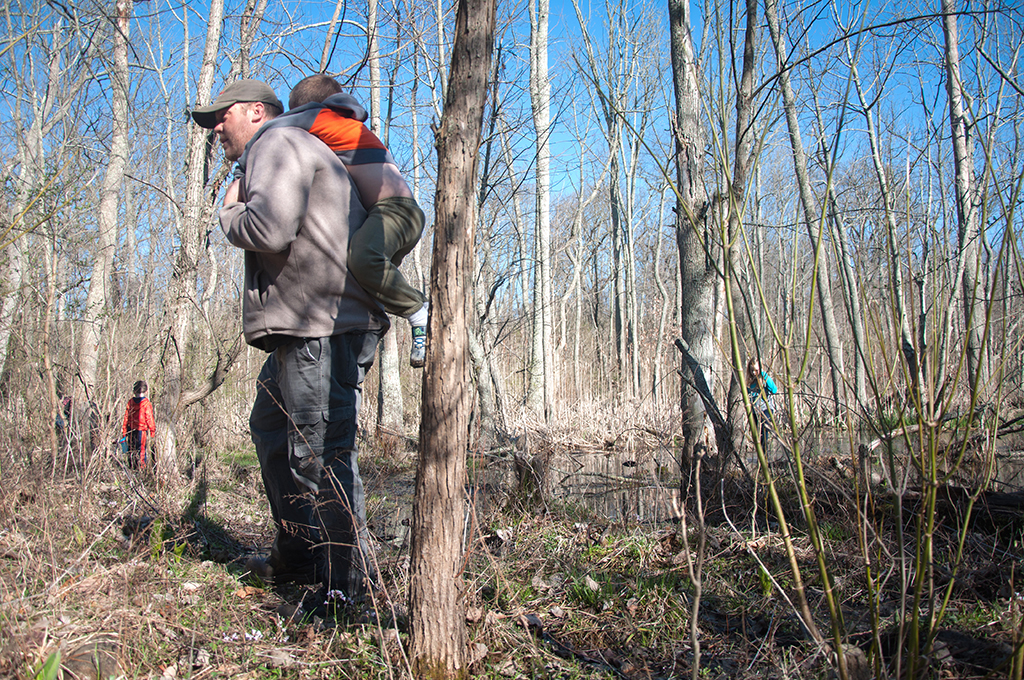So there’s a wetlands site in New Carlisle, and it’s kind of a big deal. Laden with unique and threatened plant species, the Brubaker Wetlands is hidden away just a stone’s throw from downtown, and I feel very comfortable calling it the city’s best-kept secret.
Tucked away just off the bike trail that runs through Smith Park, the wetlands truly are a separate microcosm within the city’s hustle and bustle, as the setting is somewhat surreal—full of strange, sometimes stinky plants popping up from the sodden ground—giving the visitor the impression that they’ve stepped far back in time.
One New Carlisle family is devoted to studying the wetlands and sparking an interest in the unique site among fellow residents. Having plans to schedule monthly cleanups along the trail and at the edge of the wetlands, as well as an upcoming snake survey, Nathan Ehlinger has lead the charge of bringing awareness to the unique site rich in biological diversity.
Ehlinger is a biologist who grew up in New Carlisle within sight of the wetlands. Now raising his own three children, he realized how significant the site is for its diversity and positive impact on the city’s drinking water, so he decided to promote it, hoping to instill appreciation for the wetlands in the younger generation.
Ehlinger invited myself and my editor Andy for a tour of the wetlands on Saturday afternoon—meeting us with two other members of the Tecumseh Trail group—his son Jonah and daughter Lorien. As we wandered off the trail and descended into the woods, the firm ground and thick honeysuckle immediately gave way to spongy mud and bright green whorled leaves on the ground—indicating at that line that the normal woods had stopped and the wetlands had begun.
He told us plants that grow in the wetlands will not grow in the normal part of the forest, gesturing to the first wetland species to greet us—the skunk cabbage.
He said he “remembered how alien everything looked” at the wetlands during his frequent childhood trips there—and skunk cabbage is surely one of the most alien-looking plant I’ve ever seen growing in the wild in Ohio. At the base of the plant’s leaves are fat little green and brown-striped cactus-looking things, with a wild curving, pointed tip. The little cactus-thing is actually called a spathe, and acts as a shell around the spadix inside, which is a small knob covered in tiny yellow flowers.
The bright green oval leaves that point straight up in the air have a pungent aroma when ripped open—giving off an odor that smelled to me like onions, garlic, and old cabbage—hence the name. Ehlinger stressed the importance of physically going outside in nature to learn about different species rather than just reading about them, as different senses are required to become familiar with certain plants species.
“There’s always been a big difference for me between seeing something in a book and actually going outside to learn about it,” Ehlinger said. “Some of these species you have to smell to identify, or feel them to identify.”
Hundreds of species of flowering plants call the wetlands home, including Marsh Marigold, Turtlehead, and Bloodroot, and Ehlinger noted that botanists from the Ohio Department of Natural Resources idamtified many rare species and one threatened species. The different species of plants also define different types of wetlands—as Ehlinger told us there are actually six or seven different wetlands within the larger site.
The plants aren’t the only living things in New Carlisle’s wetlands, as Ehlinger and crew plan to conduct a snake survey in the coming weeks to hopefully idamtify some rare animal species as well. By placing tarps on the ground ahead of time, Ehlinger will create warm hiding spots for the snakes to curl up under, “bringing the snakes to us,” he said.
“We’re trying to identify as many rare and threatened species as possible—especially if they’re federally-protected,” he said.
He noted that the city even has its resident beaver, which has constructed at least five dams in one section of the wetlands. He pointed out that the beaver hasn’t caused any problems, but instead, works to control water levels and create open areas that are ideal for other animal species.
“The engineering of his dam provides a habitat for migrating birds, and fish,” Ehlinger said of the beaver’s natural instincts to build.
Stressing the importance of maintaining the importance of maintaining the city’s most precious natural resource, Ehlinger said he’s been hard-pressed to find water sources as pristine as our own.
“We have one of the higher-quality watersheds in the state, and people come from far away to visit our natural resources” he said. “Very few times in the field have I come across a stream as high quality as Honey Creek.”
The Ehlingers welcome those with any interest in the wetlands to join them in their monthly trail cleanups—the first of which will be held on April 16. During these events, trash will be removed from storm water drainage sites, which he said brings in a lot of trash to the wetlands. The upcoming snake survey’s date will be announced on the group’s Facebook page—Tecumseh Trail. Contact Ehlinger on Tecumseh Trail’s Facebook page through messenger for any questions regarding participation in the cleanups or snake survey.


